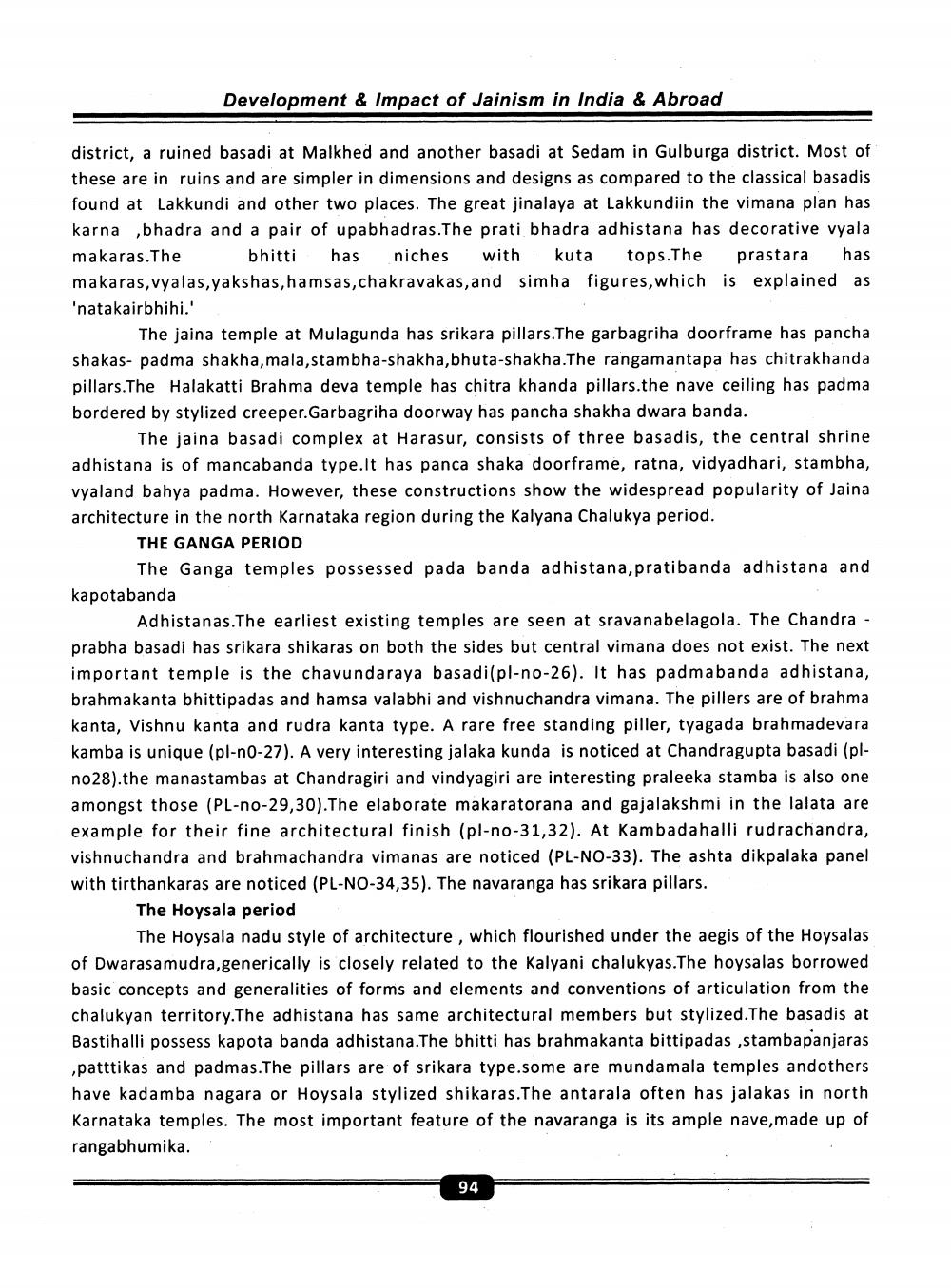________________
Development & Impact of Jainism in India & Abroad
district, a ruined basadi at Malkhed and another basadi at Sedam in Gulburga district. Most of these are in ruins and are simpler in dimensions and designs as compared to the classical basadis found at Lakkundi and other two places. The great jinalaya at Lakkundiin the vimana plan has karna ,bhadra and a pair of upabhadras.The prati bhadra adhistana has decorative vyala makaras.The bhitti has niches withkuta tops.The prastara has makaras,vyalas, yakshas, hamsas,chakravakas, and simha figures, which is explained as 'natakairbhihi.'
The jaina temple at Mulagunda has srikara pillars.The garbagriha doorframe has pancha shakas- padma shakha, mala,stambha-shakha,bhuta-shakha.The rangamantapa 'has chitrakhanda pillars.The Halakatti Brahma deva temple has chitra khanda pillars.the nave ceiling has padma bordered by stylized creeper.Garbagriha doorway has pancha shakha dwara banda.
The jaina basadi complex at Harasur, consists of three basadis, the central shrine adhistana is of mancabanda type.It has panca shaka doorframe, ratna, vidyadhari, stambha, vyaland bahya padma. However, these constructions show the widespread popularity of Jaina architecture in the north Karnataka region during the Kalyana Chalukya period.
THE GANGA PERIOD
The Ganga temples possessed pada banda adhistana,pratibanda adhistana and kapotabanda
Adhistanas.The earliest existing temples are seen at sravanabelagola. The Chandra - prabha basadi has srikara shikaras on both the sides but central vimana does not exist. The next important temple is the chavundaraya basadi(pl-no-26). It has padmabanda adhistana, brahmakanta bhittipadas and hamsa valabhi and vishnuchandra vimana. The pillers are of brahma kanta, Vishnu kanta and rudra kanta type. A rare free standing piller, tyagada brahmadevara kamba is unique (pl-n0-27). A very interesting jalaka kunda is noticed at Chandragupta basadi (plno28).the manastambas at Chandragiri and vindyagiri are interesting praleeka stamba is also one amongst those (PL-no-29,30).The elaborate makaratorana and gajalakshmi in the lalata are example for their fine architectural finish (pl-no-31,32). At Kambadahalli rudrachandra, vishnuchandra and brahmachandra vimanas are noticed (PL-NO-33). The ashta dikpalaka panel with tirthankaras are noticed (PL-NO-34,35). The navaranga has srikara pillars.
The Hoysala period
The Hoysala nadu style of architecture, which flourished under the aegis of the Hoysalas of Dwarasamudra,generically is closely related to the Kalyani chalukyas.The hoysalas borrowed basic concepts and generalities of forms and elements and conventions of articulation from the chalukyan territory.The adhistana has same architectural members but stylized.The basadis at Bastihalli possess kapota banda adhistana.The bhitti has brahmakanta bittipadas ,stambapanjaras ,patttikas and padmas.The pillars are of srikara type.some are mundamala temples andothers have kadamba nagara or Hoysala stylized shikaras.The antarala often has jalakas in north Karnataka temples. The most important feature of the navaranga is its ample nave, made up of rangabhumika.
94




